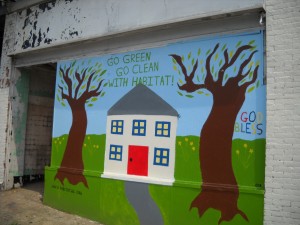
Jim Killoran has a rule for all of Habitat for Humanity”™s Yonkers development projects: no Blackberries.
“We”™re going to finish by midnight and then we”™ll bring the limos in,” Killoran said to the dozen or so volunteers working on an energy-efficient house at 5 Orchard St., just off of Ashburton Avenue.
But this is not another edition of ABC”™s popular TV series “Extreme Makeover: Home Edition,” there will be no limos rolling in at midnight and the project will extend far longer than a day or a week or even a month.
That is because the project is not just building one house; it is rebuilding an entire neighborhood.
As executive director of Habitat for Humanity”™s Westchester division, Killoran, with what seems to be a limitless amount of energy, is a dreamer. But while any venture capitalist or entrepreneur or community organizer is free to dream, Killoran and the hundreds of weekly volunteers at the Yonkers projects have brought hope and a sense of ownership back to this neighborhood that has been filled with empty storefronts and factories and homes for years.

Already, Habitat has spearheaded the construction or full-scale renovation of more than a dozen houses along the Ashburton corridor, from Walnut Street to Orchard Street to Warburton Avenue. Volunteers have cleared out lot after empty lot of debris and overgrown weeds, replacing them with vegetable gardens. Benches have been repainted, planters full of flowers are now visible from nearly every corner and graffiti on a number of vacant houses and buildings has been replaced by murals.
Of one street corner where several new units now sit, Killoran said, “They used to shoot drugs here. Now five families live here.”
A five-minute conversation with Killoran will yield a smorgasbord of ideas and initiatives. He wants to turn a vacant building near the corner of Ashburton and Orchard with $160,000 in back taxes owed into a café with tables on the sidewalk. He wants to bring business tenants back to the former carpet factories that line Nepperhan Avenue, factories that have been unoccupied for most of the last 10 to 15 years. He wants to buy six houses on High Street that have all been foreclosed and create affordable housing units for veterans returning from active duty and their families. He wants to revive a former button factory on Ashburn that has been vacant since its owner died years ago.
“Dream with me and in five years all these empty houses are filled with families,” he said. “Imagine these factories were filled again with green jobs.”

Is this all going to happen overnight? No, but the bottom line is when asked what he thought the potential for local job creation could be if businesses were talked into coming back to the neighborhood, Killoran”™s answer was “hundreds.”
“What is a blighted block can be taken back,” he said. “Bring in small-business loans programs, put in condos (above stores) and it”™s a beautiful block again.”
It is evident from a tour of the neighborhood that Killoran has local residents and shop owners hooked on the possibility of restoring jobs and businesses. Now all it will take is to convince city and state officials and donors to dream with him.
“We”™re battling the notion that it can”™t be brought back,” said Patrick Welch, an associate of Goldman Sachs who has been volunteering with Habitat in Yonkers for 13 years. “He (Jim) is constantly trying to change people”™s minds about it.”
Proponents of trickle-down economics argue for injecting capital into the upper echelons of the business world by means of tax breaks and other benefits, with the hope those economic benefits will soon work their way down the ladder.
Killoran”™s plan is the exact opposite: invest and rebuild from the bottom up, with the goal of making this area one where people will want to raise their kids, work, shop and eat. Located just a half-mile from the Hudson River, Killoran hopes that by first revitalizing the neighborhood, Habitat can help to bring businesses, jobs and tax revenue back to what was a thriving industrial center just a couple decades ago.
“There”™s a desperate need for affordable housing,” he said. “We”™re taking this dead block and helping to bring it back. We”™re doing it from the bottom up.”

















